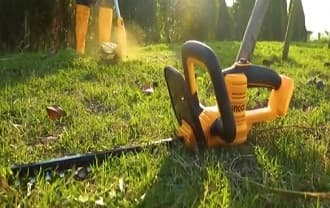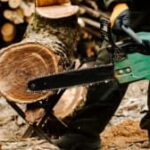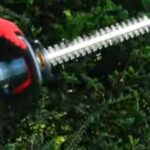As an Amazon Associate, this site earns commissions from qualifying purchases. For more information click here.
A vibrating hedge trimmer is difficult to control and leads to rough, uneven cuts. The excessive vibration might also indicate something is wrong with the tool and must be fixed right away. Keep reading to find out what is causing this and how to prevent it.
Loose bolts on the bearings, handles, crankshaft or housing will cause hedge trimmers to vibrate. Tightening the screws and bolts should fix this. If the blade is bent or incorrectly installed, it could lead to vibrations too.
Loose Cover or Housing
If your hedge trimmer is vibrating, the first thing to check is the engine housing and cover. The cover provides protection while the housing contains the engine and all its components.
Turn the trimmer off and check the cover for loose bolts or screws. Tighten the bolts and turn the hedge trimmer on again. If it no longer vibrates you fixed it. If it still does, the cover was not the cause. This works with the Garcare Pole Hedge Trimmer so you can get it running smoothly again.
Check the engine housing. Make sure the bolts are complete and tight. You should also check for loose hardware and tighten those as well. It is dangerous to use a hedge trimmer with loose fittings as the engine could break apart as you use it. If the bolts are incomplete, buy a replacement which is compatible with your trimmer.

Tighten the Bearings
Hedge trimmer bearings get damaged or suffer wear and tear. Bearings are designed to let a component move inside a stationary part so when something breaks, vibrations occur.
To find out if the bearings on your hedge trimmer are broken, examination is a must. Follow these steps.
- Shut off the hedge trimmer.
- Remove the bolts on the blade. Take off the guard tip washers as well. Set these aside for now.
- Take off the gear case covering and all the necessary bolts and washers.
- Take out the lower gear, felt seat, lower blade, upper blade, spacer plate and upper gear.
- You now have access to the drive gear. Give it a light tug. If it gives way and is too loose, remove the screw attaching the gear case onto the engine block. Use snap ring pliers to take out the retaining ring.
- Take out the clutch drum. With the pliers, take off the bearing retaining ring.
- Remove the bearings with a flywheel puller. Use the puller to reseat the bearings and realign them.
- When you are done, use the bearing rings to secure them.
- Put the clutch drum back and the ring.
Reconnect the gear case to the engine block and set the inner gear so the openings match the support. Put everything back in the reverse order you took them out.
Tighten the Handles
Usually the handles on hedge trimmers are tightened well. However the bolts can come loose for various reasons. If the trimmer was dropped, or you loosened the bolts during maintenance and forgot to tighten it, this can cause problems.
This is another area you should check for obvious reasons. You don’t want the handle to fly off while you are using it. If you have been using the trimmer for a while, you should be able to notice if the handle is loose.
Loose handles rarely happen on quality hedge trimmers – the VIVOSUN 20″ Cordless Hedge Trimmer is solidly built for instance – but if yours is old and worn out, those bolts can come loose. Regularly check them to be sure. Do not use the hedge trimmer if the handle is broken.
Bent or Damaged Blade
If the blade is missing teeth, bent, damaged or not installed correctly, the trimmer will vibrate. If your hedge trimmer runs smoothly and suddenly vibrates, something could have happened to the blade. How you fix this depends on the problem.
Note: This is also one of the reasons why some hedge trimmers only run on choke, though there are other possible causes.
How to fix bent blade teeth
- Turn the hedge trimmer off.
- Loosen the blade guide. This might require you to loosen some screws or bolts.
- Once the guide is loose, use pliers to straighten the bent tooth (or teeth).
- Tighten the bolts and try the hedge trimmer again.
How to replace the blade
If the blade has missing teeth, bent out of shape or damaged, it has to be replaced. You can buy a replacement online. As long as it is compatible with your hedge trimmer there will be no problems.
When you have a replacement blade, do the following.
- Remove the bolts holding the blade, the blade guard and tip guard.
- Take off the case cover, bolts and washers.
- Lift the felt seat and lower gear. Finally, take out the blade spacer and the blade.
- To put the new blades in, place the inner gear in a way that the holes match the blade support.
- Put the spacer plate on. Put the lower in place with the sharp end pointed away from the guide.
- Put the lower gear back and align the cam so that it is opposite the cam of the inner gear.
- Align the gear openings to the blades.
- Put the felt seal and covering on.
- Put the trimmer blades onto the support and set the guards on the bolts. Secure everything with the nuts.
Replace Crankshaft Bearings
The crankshaft is situated between the crank case and bearing. This is the last place you should look because it is very durable and unlikely to break. If you have ruled out the other possibilities and want to replace its bearings, follow this guide.
- Shut off the trimmer engine. Let it cool and then drain the fuel.
- Take out the air filter and its bracket.
- Disconnect and take out the throttle cable, fuel line, the gasket and isolator block.
- Disconnect the spark plug wire. Take out the spark plug, the engine case, the gasket for the insulator, the air vent, fuel tank and starter.
- Use a rubber mallet to separate the clutch shaft screw from the motor.
- Now you have to prevent the piston from moving. Put the starter cord into the hole where the spark plug was. This sends the cord into the cylinder and blocks the piston.
- Take off the clutch with a couple of channel locks. Tap the middle spindle with the mallet and pull the flywheel off.
- Disconnect and remove the cylinder, muffler and pulley.
- Separate the crankcase and the cylinder. Take the crankcase and separate it into two. You can accomplish this by pushing the crankshaft in the bearing. Just keep tapping with the mallet. Use the mallet to remove the crankshaft.
- Take out the bearing seals on the shaft. Position the crankcase with the seal facing down. Put a screwdriver in the middle and tap it with the mallet.
- Get a socket big enough for the bearing and keep tapping with the mallet until the bearings come off.
Now you can install new crankshaft bearings. Those will come with instructions specific for your hedge trimmer. Once the bearings are in place, put everything back together in the reverse order which you took them out.
Overheating Engine
In rare cases, an overheating engine might cause a hedge trimmer to vibrate. When an engine overheats, a lot of things can go wrong quickly. Under certain conditions, the bearings or blade cold come loose. This does not happen often but it can take place.
The solution to this is simple. Let the hedge trimmer cool down. When the engine has cooled, take a look if any bolts have come loose. Tighten them again. If there is a lot of shaking when the temperature goes up, there could be some loose parts in the engine itself.
As much as possible, run the hedge trimmer in the suggested temperature range by the manufacturer. If that is not always possible, let it cool down. Allow it to rest so the engine can recover. Performing regular maintenance on your hedge trimmer will also help.

I love the outdoors and all the tools for maintaining gardens, yards and lawns. The only thing I am more passionate about is sharing what I know about garden and outdoor equipment.


